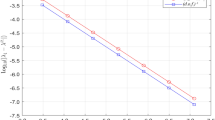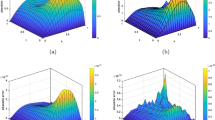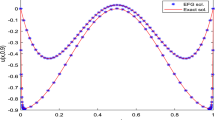Abstract
The Flux Reconstruction (FR) approach to high-order methods is a flexible and robust framework that has proven to be a promising alternative to the traditional Discontinuous Galerkin (DG) schemes on parallel architectures like Graphical Processing Units (GPUs) since it pairs exceptionally well with explicit time-stepping methods. The FR formulation was originally proposed by Huynh (AIAA Pap 2007-4079:1–42, 2007). Vincent et al. (J Sci Comput 47(1):50–72, 2011) later developed a single parameter family of correction functions which provide energy stable schemes under this formulation in 1D. These schemes, known as Vincent–Castonguay–Jameson–Huynh (VCJH) schemes, offer control over properties like stability, dispersion and dissipation through the variation of the VCJH parameter. Classical schemes like nodal-DG and Spectral Difference (SD) can also be recovered under this formulation. Following the development of the FR approach in 1D, Castonguay et al. (J Sci Comput 51(1):224–256, 2012) and Williams et al. (J Comput Phys 250:53–76, 2013) and Williams and Jameson (J Sci Comput 59(3):721–759, 2014) developed correction functions that give rise to energy stable FR formulations for triangles and tetrahedra. For the case of tensor product elements like quadrilaterals and hexahedra however, a simple extension of the 1D FR approach utilizing the 1D VCJH correction functions was possible and has been adopted by several authors (Castonguay in High-order energy stable flux reconstruction schemes for fluid flow simulations on unstructured grids, 2012; Witherden et al. in Comput Fluids 120:173–186, 2015; Comput Phys Commun 185(11):3028–3040, 2014). But whether such an extension of the 1D approach to tensor product elements is stable remained an open question. A direct extension of the 1D stability analysis fails due to certain key difficulties which necessitate the formulation of a norm different from the one utilized for stability analysis in 1D and on simplex elements. We have recently overcome these issues and shown that the VCJH schemes are stable for the linear advection equation on Cartesian meshes for any non-negative value of the VCJH parameter (Sheshadri and Jameson in J Sci Comput 67(2):769–790, 2016; J Sci Comput 67(2):791–794, 2016). In this paper, we have extended the stability analysis to the advection–diffusion equation, demonstrating that the tensor product FR formulation is stable on Cartesian meshes for the advection–diffusion case as well. The analysis in this paper also provides additional insights into the dependence on the VCJH parameter of the diffusion and stability characteristics of these schemes. Several numerical experiments that support the theoretical results are included.







Similar content being viewed by others

References
Reed, W.H., Hill, T.R.: Triangular Mesh Methods for the Neutron Transport Equation. In: Proceedings of the American Nuclear Society (1973)
Cockburn, B., Shu, C.-W.: The local discontinuous Galerkin method for time-dependent convection–diffusion systems. SIAM J. Numer. Anal. 10(2), 443–461 (2000)
Peraire, J., Persson, P.-O.: The compact discontinuous Galerkin (CDG) method for elliptic problems. SIAM J. Sci. Comput. 30(4), 1806–1824 (2008)
Douglas, J., Dupont, T.: Interior penalty procedures for elliptic and parabolic Galerkin methods. In: Computing Methods in Applied Sciences, pp. 207–216. Springer Berlin Heidelberg, Berlin, Heidelberg (1976)
Bassi, F., Rebay, S.: A high-order accurate discontinuous finite element method for the numerical solution of the compressible Navier–Stokes equations. J. Comput. Phys. 131(2), 267–279 (1997)
Cockburn, B., Gopalakrishnan, J., Lazarov, R.: Unified hybridization of discontinuous Galerkin, mixed and continuous Galerkin methods for second order elliptic problems. Math. Stat. Fac. Publ. Present. 59 (2009) http://pdxscholar.library.pdx.edu/mth_fac/59
Cockburn, B., Karniadakis, G.E., Shu, C.W., Griebel, M.: Discontinuous Galerkin Methods Theory, Computation and Applications. Lectures Notes in Computational Science and Engineering, vol. 11. Inc. Marzo del (2000)
Hesthaven, J.S., Warburton, T.: Nodal Discontinuous Galerkin Methods: Algorithms, Analysis, and Applications. Springer (Incorporated, 2010)
Kopriva, D.A., Kolias, J.H.: A conservative staggered-grid chebyshev multidomain method for compressible flows. J. Comput. Phys. 125(1), 244–261 (1996)
Liu, Y., Vinokur, M., Wang, Z.J.: Spectral difference method for unstructured grids I: basic formulation. J. Comput. Phys. 216(2), 780–801 (2006)
Witherden, F.D., Vermeire, B.C., Vincent, P.E.: Heterogeneous computing on mixed unstructured grids with PyFR. Comput. Fluids 120, 173–186 (2015)
Vincent, P.E., Castonguay, P., Jameson, A.: A new class of high-order energy stable flux reconstruction schemes. J. Sci. Comput. 47(1), 50–72 (2011)
Jameson, A.: A proof of the stability of the spectral difference method for all orders of accuracy. J. Sci. Comput. 45(1–3), 348–358 (2010)
Allaneau, Y., Jameson, A.: Connections between the filtered discontinuous Galerkin method and the flux reconstruction approach to high order discretizations. Comput. Methods Appl. Mech. Eng. 200(49–52), 3628–3636 (2011)
De Grazia, D., Mengaldo, G., Moxey, D., Vincent, P.E., Sherwin, S.J.: Connections between the discontinuous Galerkin method and high-order flux reconstruction schemes. Int. J. Numer. Methods Fluids 75(12), 860–877 (2014)
Zwanenburg, P., Nadarajah, S.: Equivalence between the energy stable flux reconstruction and filtered discontinuous Galerkin schemes. J. Comput. Phys. 306, 343–369 (2016)
Mengaldo, G.: Discontinuous Spectral/hp Element Methods: Development, Analysis and Applications to Compressible Flows. PhD thesis (2015)
Mengaldo, G., De Grazia, D., Vincent, P.E., Sherwin, S.J.: On the connections between discontinuous Galerkin and flux reconstruction schemes: extension to curvilinear meshes. J. Sci. Comput. 67(3), 1272–1292 (2016)
Wang, Z.J., Gao, H.: A unifying lifting collocation penalty formulation including the discontinuous Galerkin, spectral volume/difference methods for conservation laws on mixed grids. J. Comput. Phys. 228(21), 8161–8186 (2009)
Jameson, A., Vincent, P.E., Castonguay, P.: On the non-linear stability of flux reconstruction schemes. J. Sci. Comput. 50(2), 434–445 (2012)
Mengaldo, G., De Grazia, D., Moxey, D., Vincent, P.E., Sherwin, S.J.: Dealiasing techniques for high-order spectral element methods on regular and irregular grids. J. Comput. Phys. 299, 56–81 (2015)
Castonguay, P., Vincent, P.E., Jameson, A.: A new class of high-order energy stable flux reconstruction schemes for triangular elements. J. Sci. Comput. 51(1), 224–256 (2012)
Williams, D.M., Castonguay, P., Vincent, P.E., Jameson, A.: Energy stable flux reconstruction schemes for advection-diffusion problems on triangles. J. Comput. Phys. 250, 53–76 (2013)
Williams, D.M., Jameson, A.: Energy stable flux reconstruction schemes for advection–diffusion problems on tetrahedra. J. Sci. Comput. 59(3), 721–759 (2014)
Castonguay, P.: High-Order Energy Stable Flux Reconstruction Schemes for Fluid Flow Simulations on Unstructured Grids. PhD thesis (2012)
Sheshadri, A., Jameson, A.: On the stability of the flux reconstruction schemes on quadrilateral elements for the linear advection equation. J. Sci. Comput. 67(2), 769–790 (2016)
Sheshadri, A., Jameson, A.: Erratum to: On the stability of the flux reconstruction schemes on quadrilateral elements for the linear advection equation. J. Sci. Comput. 67(2), 791–794 (2016)
Castonguay, P., Williams, D.M., Vincent, P.E., Jameson, A.: Energy stable flux reconstruction schemes for advection–diffusion problems. Comput. Methods Appl. Mech. Eng. 267, 400–417 (2013)
Huynh, H.T.: A flux reconstruction approach to high-order schemes including discontinuous Galerkin methods. AIAA Pap. 2007-4079, 1–42 (2007)
Huynh, H.T.: A reconstruction approach to high-order schemes including discontinuous Galerkin for diffusion. In: 47th AIAA Aerospace Sciences Meeting (2009)
Sheshadri, A.: An Analysis of Stability of the Flux Reconstruction Formulation with Applications to Shock Capturing. PhD thesis, Stanford University (2016)
Witherden, F.D., Farrington, A.M., Vincent, P.E.: PyFR: an open source framework for solving advection-diffusion type problems on streaming architectures using the flux reconstruction approach. Comput. Phys. Commun. 185(11), 3028–3040 (2014)
Acknowledgements
The authors would like to thank the Stanford Graduate Fellowship (SGF) and the Air Force Office of Scientific Research (Grant FA-9550-14-1-0186) for supporting their research.
Author information
Authors and Affiliations
Corresponding author
Rights and permissions
About this article
Cite this article
Sheshadri, A., Jameson, A. An Analysis of Stability of the Flux Reconstruction Formulation on Quadrilateral Elements for the Linear Advection–Diffusion Equation. J Sci Comput 74, 1757–1785 (2018). https://doi.org/10.1007/s10915-017-0513-9
Received:
Revised:
Accepted:
Published:
Issue Date:
DOI: https://doi.org/10.1007/s10915-017-0513-9



